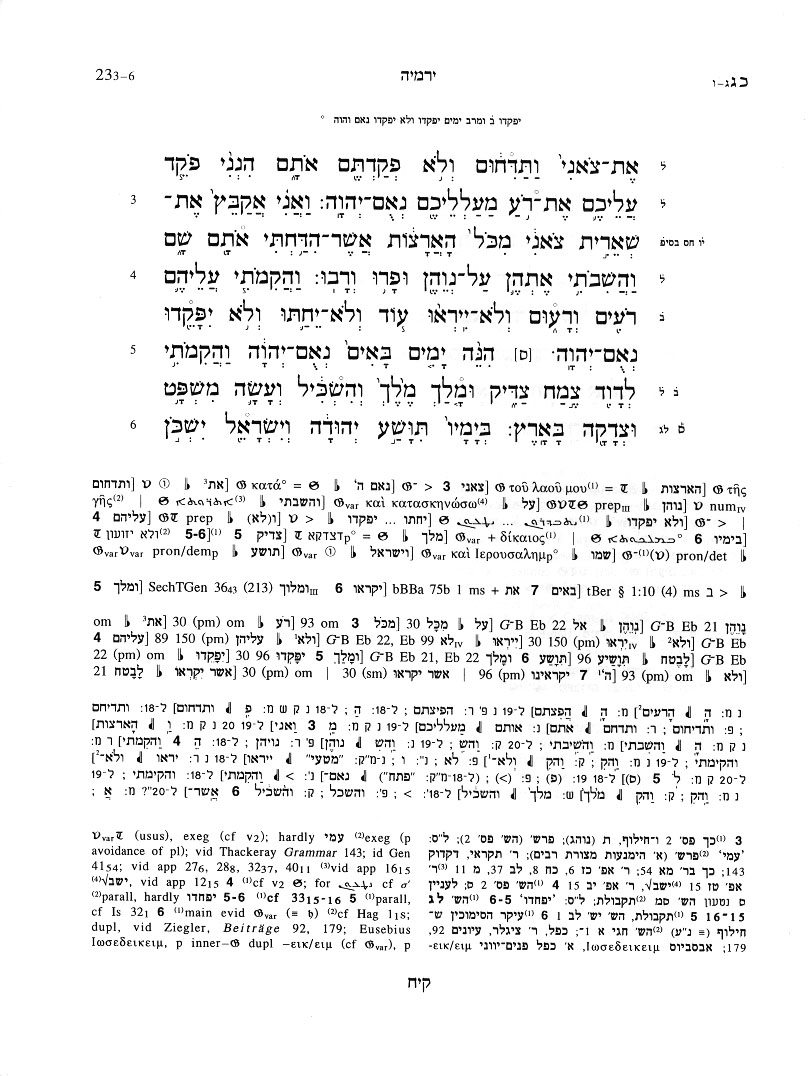Mar 05, 2016 This study edition offers the established text of the Biblia Hebraica Stuttgartensia (BHS) in a convenient format and at an extremely attractive price. Published by Karl Elliger and Wilhelm Rudolph, together with numerous scholars. 5th, improved edition (1997), edited by Adrian Schenker. The sigla (symbols & abbrev.) used in the apparatus are explained in the Prolegomena beginning on p. Although the explanations are all in Latin, most are easily understood. An English key is available to use with your BHS: H.P. Ruger, An English Key to the Latin Words and Abbreviations and the Symbols of Biblia Hebraica Stuttgartensia. Biblia Hebraica Stuttgartensia Genesis 1 3. The Biblia Hebraica Stuttgartensia is a revision of Rudolf Kittel's Biblia Hebraica, based upon the Leningrad Codex B19A, the oldest dated manuscript of the complete Hebrew Bible. Also included is the Biblia Hebraica Stuttgartensia Apparatus Criticus and the WIVU Introduction. This Stuttgart Electronic Study Edition of the BHS is based upon the morpho-syntactic database of Prof. Eep Talstra and the Free University, Amsterdam.
Biblia Hebraica Pdf
3. The מָסוֹרָה קְטַנָּה, is found in BHS on the outside margins of the page. This is also known by its Latin name, the Masora parva. These are notes written in a combination of Aramaic and abbreviations, which helped copyists and readers preserve the text exactly by noting unusual forms. For example, וְהָאֱלֹהִים in v. 1 has a circle above it; this connects it to the marginal note to the left of that verse, the first of which reads ז, representing the numeral 7. (ז is the seventh letter of the Hebrew alphabet.) This means that the word וְהָאֱלֹהִים (with both the definite article and the conjunction) is found seven times in the Hebrew Bible. The system behind these notes is quite complex, and will not be examined here; those interested should consult Israel Yeivin, Introduction to the Tiberian Masorah, translated and edited by E. J. Revell (1985) or his newer Hebrew book המסורה למקרא published in 2003, as well asThe Masorah of Biblia Hebraica Stuttgartensia: Introduction and Annotated Glossary, by Page Kelley (1998).
4. A modified form of the מָסוֹרָה גְּדוֹלָה is found in BHS immediately below the biblical text. This is also known as the Masora magna. The main function of the מָסוֹרָה גְּדוֹלָה was to elucidate some notes in the מָסוֹרָה קְטַנָּה by adding specific biblical references. For example, the מָסוֹרָה גְּדוֹלָה notes that the word וְהָאֱלֹהִים in Gen 22:1 is one of seven occurrences of the word וְהָאֱלֹהִים in that form, and the מָסוֹרָה גְּדוֹלָה might indicate where the other six occurrences were. However, since these notes were compiled before chapter and verse numbers were inserted into the Hebrew Bible, the traditional מָסוֹרָה גְּדוֹלָה would do this by quoting part of the verse of each occurrence. This is no longer necessary, so BHS has created a new type of מָסוֹרָה גְּדוֹלָה, expanding upon the notes in the מָסוֹרָה גְּדוֹלָה in a volume by G. E. Weil, Massorah Gedolah. For example, the מָסוֹרָה קְטַנָּה for 22:1 noted that וְהָאֱלֹהִים is found seven times; that ז is followed by a superscript 1, which is a footnote marker, referring to the 1 which follows Cp 22 (chapter 22) on the first line below the end of the Hebrew text. That note reads 1Mm 145, which means that the seven occurrences may be found by looking up Weil'sMassorah Gedolah (1971), number 145. These notes are sometimes useful for finding particular forms or patterns which are noted in the Masorah, but there are usually easier ways to find the same information, such using a concordance (see the page on concordances here).
Not all printed Bibles are identical; different Bible editions show differences in vocalization and more rarely in the consonantal text. The standard complete critical biblical text is Biblia Hebraica Stuttgartensia (abbreviated BHS), and was published as a complete work in 1977. It uses as its basis a biblical manuscript from the year 1008. Using the Apparatus in Biblia Hebraica Stuttgartensia-Basic Terms A key to the apparatus is provided on pp. Xliv-l (unfortunately only in Latin). Listed below are some of the basic concepts. At times an English key is provided with the purchase of your Hebrew Bible. A squiggle = Samaritan Pentateuch ’ θ = Aquila 2nd c. CE translation. Biblia Hebraica Stuttgartensia Genesis 1 3.
Biblia Hebraica Stuttgartensia Pdf Espanol
Since textual criticism is as much an art as a science, and each edition of a scholarly work bears the particular assumptions and understandings of its editors, BHS or any edition of the Bible cannot be considered definitive. In addition, since the time BHS was completed, additional textual evidence, especially from the Dead Sea Scrolls, has been published. It is thus not surprising that at least three other projects to produce critical editions of the Hebrew Bible are underway (see here). Yet BHS remains especially important since it is the most recent complete scholarly edition of the Bible.

The Primary Evidence used by BHS and other Critical Bibles
Each of the versions is also documented in a variety of manuscripts, and exists in critical editions based on what its editors think is the best or most original version. These non-Hebrew 'textual witnesses' are discussed in detail in Tov, Textual Criticism of the Hebrew Bible, 23-154. Students who do not have access to the original languages and resources will find the following two resources, helpful: Eugene Ulrich, The Biblical Qumran Scrolls: Transcriptions and Textual Variants (Brill, 2010) andA New English Translation of the Septuagint, by Albert Pietersma and Benjamin G. Wright (Oxford University Press, 2007).